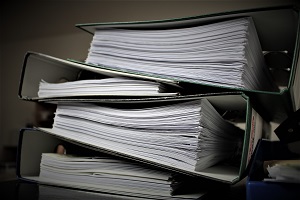Document procedures and archiving
As an authority, KTH is obliged to store, prepare and receive public documents. Examples of such documents are KTH's research reports and course documents. The handling of public documents is governed by laws and regulations.
How to manage your documents

What documents must be kept / be registered?
This guide is to simplify for you out at the department that will archive documents. It is an abbreviation of the central document management plan. (Complete information can be found in the Document Management Plan.)
Download the archiving guide (pdf 69 kB) (only in Swedish)
Document management in general
Registration management is done in the W3D3 system, which is an administrative support system for registering of public documents.
Other ways to manage documents:
- Registration in IT system
- Sort into binder
- Submit to administrator according to school routines
Archiving Tips
To keep in mind when archiving:
- Remove plastic folders and paper clips.
- Find out whether the documents should be kept together or stored separately: use file folders (a folded A3 paper). When selecting document covers: please use paper weighing more than 120gr / m2 (regular office paper: 100 gr / m2) or ISO 9706 (age-resistant) or stiffer ISO 11108 (archive cover).
- Remove drafts and removable note sheets (eg Post-it) that are of no significance. Please note: Please contact administrator concerning questions about this.
- Printed publications (compendiums, reports, etc.): Do not archive print originals if a copy is available. The original may contain tape (after a while), correction fluid / color (Tipp-ex may crawl after some time), paste or anything that destroys the action.
- If you think the document may be molded (the document may be "water damaged" and smell bad) or if you find silverfish or other insects, contact UF / DFK immediately.
- If need to print on the cover: Use pen with file-resistant ink (on the ink cartridge it should be "Swedish archive" or "ISO 12757-2").
- Is the collection of documents complete in this case? Which gaps exist, ie missing eg protocol for a certain year and what can the cause be (the documents are lost, stored elsewhere, not established this year, etc.).
- Separate the documents to be retained and those to be deleted.
- Are records for thesis work, dissertations and publications updated? If the administrator uses some form of registers or lists, these should also be saved.
- Storage: The documents are to be kept in archive boxes approved by Riksarkivet (see RA-FS 2006: 4, chapter 4, 8-9 §). Documents that do not fit into an archive box: contact UF / DFK for advice. The text on the archive box: Must contain at least archives, types of documents and years. The text is written with pencil.
In order for the archive box to protect the documents, do not fill it up to max or with too few documents (as there is a risk for the documents being folded).
